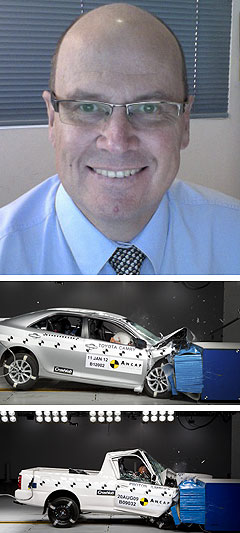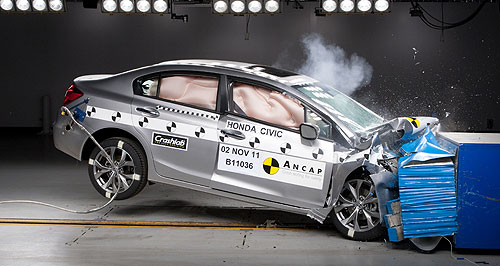Make / Model Search
News - General News - SafetySafer cars key to reducing road toll: ANCAPTesting times: Car makers will have to work a lot harder to achieve a five-star ANCAP safety rating in the near future as the organisation and its international counterparts get ready to move the goalposts. ANCAP says big drop in road toll achievable with hi-tech safety aids23 Mar 2012 THE federal government’s National Road Safety Strategy target of reducing the number of deaths and serious injuries on Australia’s roads is a “reasonably conservative” one, according to chairman of the Australasian New Car Assessment Program (ANCAP), Nicholas Clarke. ANCAP believes the proliferation of safer vehicles and the retirement of older, unsafe vehicles will make a significant contribution to improving the road toll – which currently stands at around five deaths per day and 85 serious injuries – including two permanent injuries. Mr Clarke said the road toll costs the Australian economy an estimated $27 billion per year – around the same as the federal defence budget – and Safe Work Australia reports that vehicles are involved in one third of work-related deaths. Since its inception in1992 ANCAP has overcome initial suspicion and resistance from the car industry – which has gone from not discussing ANCAP results to embracing a five-star safety rating as a marketing tool – and now the crash-testing organisation is trying to build consumer awareness and educate car buyers about the merits of selecting a safe vehicle.  Left: ANCAP chairman Nicholas Clarke. Below: ANCAP frontal crash tests for Toyota Camry (5 stars) and Proton Jumbuck (1 star). Left: ANCAP chairman Nicholas Clarke. Below: ANCAP frontal crash tests for Toyota Camry (5 stars) and Proton Jumbuck (1 star).Advances in vehicle technology can happen far more quickly than changes in driver behaviour or improvements to infrastructure, so the ever-increasing influence of organisations like ANCAP will become a driving force in safety improvements as manufacturers chase the holy grail of a five-star result. While the ANCAP has scored a win with some Australian fleets now having a five-star only vehicle policy, it understands private buyers will often opt for a used car. To this end it is targeting the public with a customer awareness campaign, designed to make car buyers think twice before buying a car with less than four safety stars backed by a website listing all its test results and even a mobile version aimed at enabling potential purchasers to instantly find out the safety rating of a prospective purchase via smart phone from the dealer’s forecourt. With many passenger vehicles now achieving the maximum five-star safety rating for their ability to protect occupants in a collision, ANCAP and its international counterparts are now shifting their focus to technology that can prevent accidents happening in the first place. Mr Clarke believes that along with ever-improving crash protection, “removing the driver from the equation” by encouraging the standard fitment of human error-correcting technology already on the market, or in the late stages of development, will result in plummeting road toll figures. Examples of technologies already available include fatigue detection, lane departure warning, blind-spot monitoring and radar or camera-based systems that detect a likely collision and alert the driver or apply the brakes – and many of these potentially life-saving electronics are no longer the preserve of premium brand vehicles. In line with its five-year road map published in February last year, ANCAP has begun testing cars for pedestrian impact safety and whiplash protection and will introduce roof strength testing in 2014 to assess the ability of cars to protect occupants in the event of a roll-over accident. The popularity of high-riding, top-heavy SUVs and light trucks in Australia highlights the importance of a roof strength test, which will consist of a force being exerted on a vehicle’s roof to simulate the impact of a roll-over. By 2017 gaining a five-star ANCAP rating will become even tougher, when accident-avoiding technology will become compulsory, joining existing mandatory equipment like front side airbags (which became a condition of a five-star rating in 2004) and electronic stability control (made mandatory for a five-star rating in 2008 and recently became an Australian Design Rule requirement for new cars). As collision-avoidance systems have not yet reached market maturity or any kind of standardisation and new ones are constantly being developed, ANCAP and other international road safety bodies are still deciding which to make mandatory. Mr Clarke said that for now, the plan is to offer a “pick list” of technologies vehicle manufacturers can choose to include, and new equipment will be added to the list, if manufacturers can prove to ANCAP it is worthwhile. “We have a process for allowing technologies (onto the pick list),” he said. “Manufacturers cannot just say they have a new technology, they have to provide some evidence and demonstrate to our engineers it is valid.” As the technologies prove their worth in the real world, ANCAP and its international partners will decide which to make mandatory for a five-star rating. In addition to the more sophisticated systems mentioned above, safety measures taken for granted by owners of many modern cars are also on the pick list, such as tyre pressure monitoring, daytime running lights, reversing sensors or cameras, hill start assistance and speed limiters. Mr Clarke used the example of the current Ford Mondeo Titanium, which is relatively affordable at less than $45,000 and features lane departure warning, blind spot monitoring, fatigue detection, front collision warning and daytime running lights as standard equipment – in addition to the qualities required for its five-star ANCAP score. He said there is now little excuse for buying an unsafe car (any car scoring less than four stars), as the first to be awarded five stars, the Renault Laguna, achieved this eight years ago and five-star cars have since proliferated, with even low-cost light cars now regularly getting five out of five. As a result, the notion of buying teenage children an old, cheap car when they pass their driving test “because they’ll crash it” is long outdated and buying them a modern, safe car for the same reason makes far more sense.  Read more |
Click to shareGeneral News articlesResearch General News Motor industry news |










Facebook Twitter Instagram